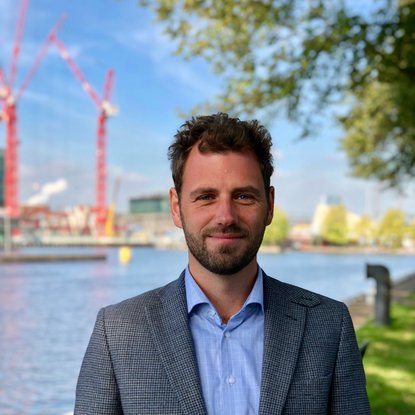For most recent updates and news on Responsible Sensing Lab please visit the website: www.responsiblesensinglab.org
A lab for a 'responsible' Smart City
The City of Amsterdam has many smart technologies in place: from smart devices that measure things (i.e. sensors) to smart devices that steer processes in the city (i.e. actuators) such as traffic lights, charging stations, adaptable street lights, barriers that go up and down, and adaptive digital signs.
With our Responsible Urban Digitization program, we research, develop and integrate smart technologies like the aforementioned to help solve urban challenges. At the same time, we explore how to embed society’s public and democratic values in the design of these innovations.
As part of this program, we launched the Responsible Sensing Lab (RSL) on in January 2021 during an interactive livestream event. In essence this Lab is a testbed for conducting rigorous, transparent, and replicable research how our smart technologies placed in public space can be designed in a way that makes the digital city ‘responsible’.
(Re)designing, prototype testing and implementing responsible sensing systems
In the Responsible Sensing Lab academics are invited to connect and work with practitioners who are responsible for digital systems in the city to (re)design, prototype and test (more) responsible ways of sensing in public space for and with the City of Amsterdam.
Hence, the Lab is a place where teams of multi-disciplinary stakeholders – such as computer scientists, policy makers, psychologists, designers and hardware experts – can address existing hardware, software and other city sensing systems.
Want to stay updated on activities and updates of the Responsible Sensing Lab? Register for our Newsletter here >>
“Responsible Sensing Lab is a place where experimentation and technologies come together to (re)design these innovations solutions that make public spaces cleaner, smarter and easier – while at the same time guaranteeing our social values.”
Smart technologies in the city
Throughout the city there are over 200 cameras, about 230 air quality sensors and almost 500 beacons in place. The latter being devices in physical spaces that emit a signal that can be picked up by mobile devices with a specific app.
Smart technologies like these help the municipality to efficiently measure, analyse and steer processes in the urban area. For example to optimize mobility flows in urban environments, to better use available capacity of energy infrastructures, to conduct condition management on the city’s assets, rationalize garbage removal and much more.
Responsible Urban Digitization
On the one hand, innovations like these can help improve the quality of life in the city and enhance safety and efficiency, but also sustainability and livability. Simultaneously, such novel technologies can impact society quite broadly. They could have consequences for matters that citizens value greatly, such as autonomy, privacy, transparency, inclusiveness and empowerment.
“The City does not want its inhabitants negatively impacted by potential privacy infringements, sense of loss of control and understandability, or reactions such as self-censorship.”
Sigrid Winkel | Urban Innovation Officer | City of Amsterdam Chief Technology Office
“Our recent research has pointed out that ‘official’ actors primarily see transparency as a mean to ensure adoption, while citizens see transparency as a starting point for voicing their concerns and influencing the purpose and use of smart technology. This leads us to conclude that we - as designers of these systems - need to aim to design these systems for engagement as well as pushback by society.”
Gerd Kortuem
Professor & AMS PI
6 steps on how to use sensors in a responsible way in public space
Together with the Responsible Sensing Lab, CITIXL created the Responsible Sensing Toolkit that helps municipalities and organizations to implement public sensors in a responsible way. Are you a city innovator thinking about deploying sensors for crowd monitoring? The Toolkit will guide you step-by-step on your journey. Click here for more information >>

Responsible Sensing Lab toolkit: 6 steps on how to use sensors in a responsible way in public space
4 cases: Human Scan Car, Transparant Charging Station, Camera Shutter and mmWAVE
A few examples of projects that we explore in the Responsible Sensing Lab are the Human Scan Car, Transparent Charging Station, Shuttercam, and mmWave sensor (part of Simple Sensors project).
Firstly, scan cars – vehicles that are equipped with sensors to collect data on the urban environment – are becoming increasingly popular to help the municipality to carry out tasks efficiently. For example with parking policy enforcement, waste registration and advertisement taxation. Apart from making the city more efficient and clean, with this project we question and explore what public and democratic values should be embedded in the implementation of these scan cars.
Together with UNSense, we invited representatives from the City of Amsterdam and Rotterdam, TADA and researchers from TU Delft to join us for a 3-day sprint to design “the scan car of the future”, that also looks at the human and fair values of the advances in technology. To get a full impression of this design sprint, you're welcome to download this booklet.
“Design should play a role in guiding the perceptions of, and interactions with, automated sensing systems in the city. Going through this process with AMS Institute's researchers and public servants, we’ll be able to bend the design towards a more consciously chosen, collectively desirable future.”
Tessa Steenkamp | Sensorial Experience Designer | UNSense

Secondly, the transparent charging station is a design project meant to explain smart charging algorithm decisions to users. In the near future, when electric cars become more prevelant, the electicity grid will no longer be able to charge all electric cars at the same time.
Smart charging algorithms will help coordinate which car will get to charge at what time. But how do these algorithms decide? The transparent charging station project produces the first user interface informing people about smart charging decisions.
“The transparent charging station promises to improve the democratic oversight of algorithms in EV charging. By explaining charging algorithm inputs, procedures and outputs in a user interface, EV drivers should be able to determine the system's fairness and see who the responsible parties are.”
Kars Alfrink | Doctoral Researcher | TU Delft

Thirdly, the Shuttercam project originated based on the notion that people do not know if and when cameras in public space are recording or not. We wondered: would people like to live in a city where all city cameras clearly show or state when they’re not in use? What if, just like laptop shutters many people have placed over their webcam, this could be a way to make clear to citizens when a camera is not recording them?
For this project, at first a time lapse camera at the office of AMS Institute was outfitted with a shutter. Subsequently, the effects of this small-scale pilot will be examined by interviewing staff and visitors. Currently, there are a number of Shuttercams tested at Marineterrein Amsterdam Living Lab.
Lastly, with the mmWAVE project we're investigating a privacy-friendly alternative for CCTV in the city. To illustrate, the Corona crisis makes it more urgent to measure crowds in popular places. The mmWave sensor sees moving objects (such as people) as a collection of points in space. This way we 'keep an eye' on crowds and movements while maintaining the privacy of the Amsterdammer.
mmWAVE sensor at Marineterrein Amsterdam
Core values for responsible urban digitization
At the Responsible Sensing Lab, and for Responsible Urban Digitization program as a whole, we use the City’s values (TADA, Digital City Agenda) as our starting point. We will explore what these values mean when applied to actual digital software and hardware.
Also, we are inspired by the methodology of value sensitive design. This approach allows us to focus on design choices inherent in the type of sensing hardware, the distribution of intelligence between cloud and back-end, the physical design and placement of sensors in public space, and interaction possibilities for citizens.
Recently, a three year collaboration has been signed between the City of Amsterdam and AMS Institute. In this Lab, we’ll work closely with experts at TU Delft Industrial Design Faculty.
| Related Information: |
Principal Investigators
Project members
Partners





